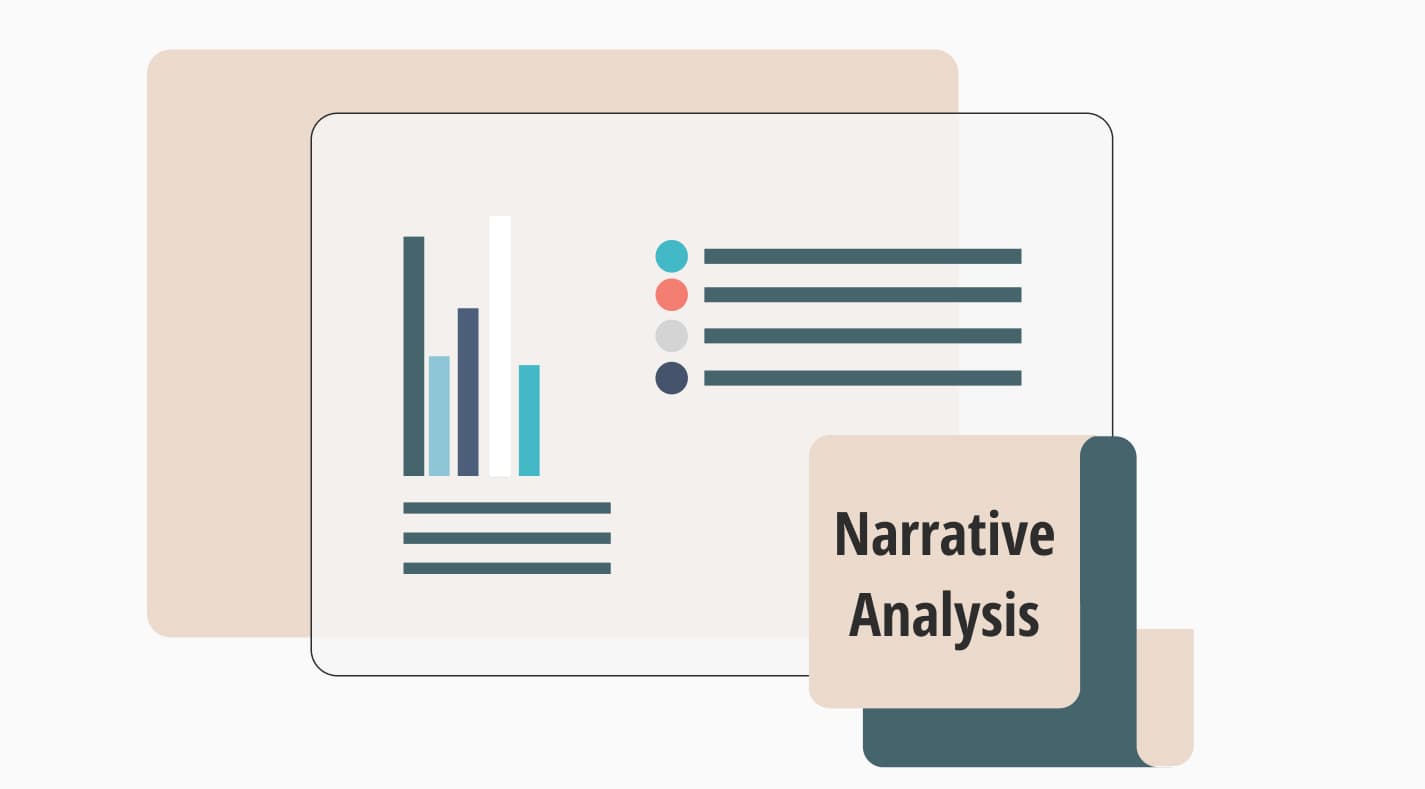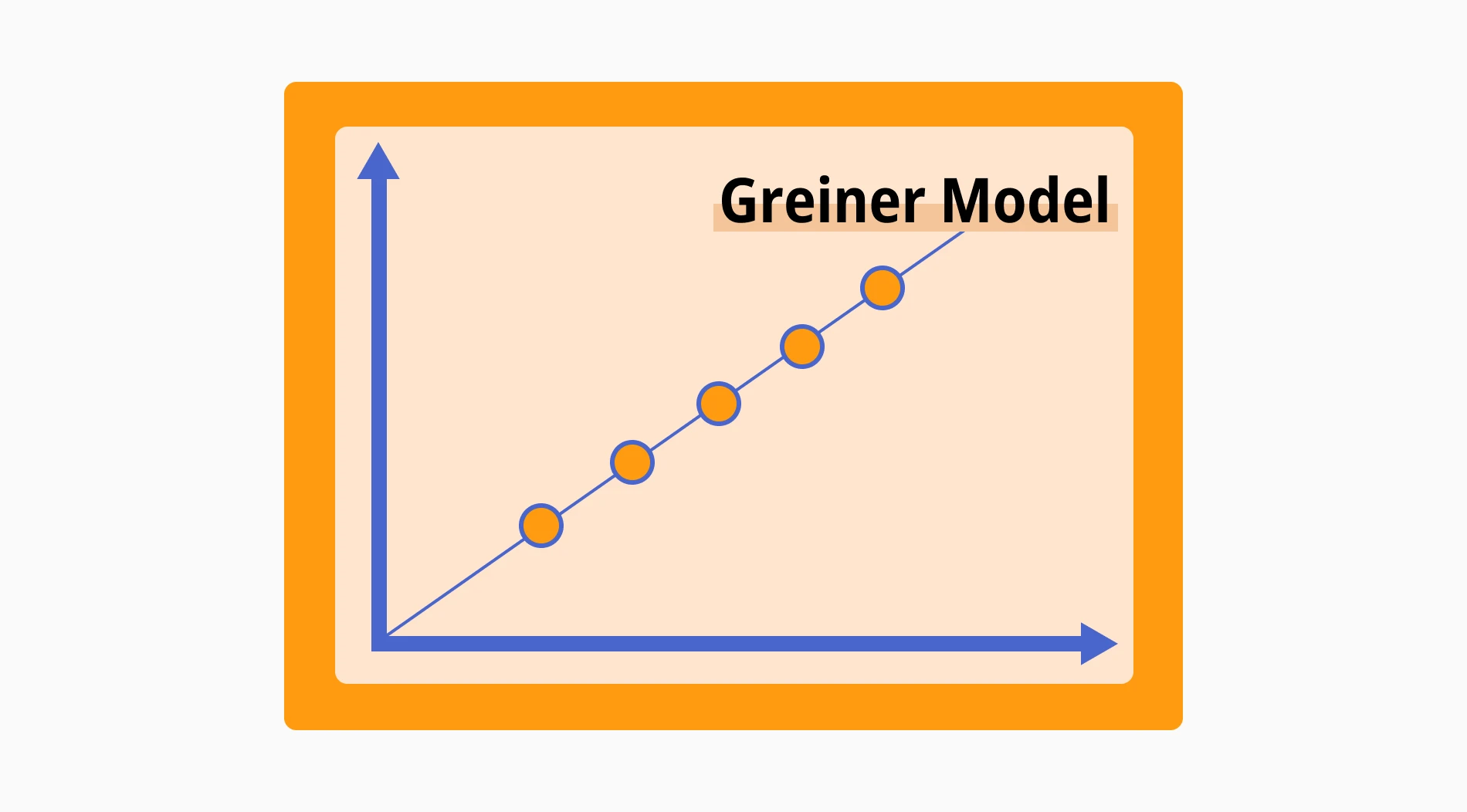
In today's fast-paced business world, companies face numerous challenges as they grow and evolve. Understanding and navigating these challenges is crucial for success. There are tools offering valuable insights into the stages of organizational growth and crises. By using such models, businesses can anticipate problems, plan effectively, and ensure sustainable growth.
This article will explore one of these models, the Greiner Model. It is a tool designed to help businesses understand and manage growth. We will explain its components in detail and provide a template for using it in your company. Additionally, we will discuss why this model is important, give real-life examples, and outline its advantages and disadvantages.
What is the Greiner model?

The Greiner Model, developed by Larry E. Greiner, is a framework that describes the five phases of organizational growth.
Each phase represents a stage of development that companies typically go through as they expand. The model also identifies specific crises that organizations may encounter at each stage. It offers insights into how to address them effectively.
The first phase of The Greiner Model is Creativity, where companies focus on innovation and product development. During this stage, leadership is often informal, and communication is fluid. However, as the company grows, this phase often leads to a Leadership Crisis. Here, there is the need for more structured management becomes evident.
The subsequent phases include Direction, Delegation, Coordination, and Collaboration. Each phase has specific challenges and necessary shifts in management practices. For example, the Direction phase involves establishing clear goals and roles, while the Delegation phase emphasizes empowering middle management. Understanding these phases helps leaders prepare for and manage the complexities of organizational growth.
The Greiner Model: Explained
We have summarized the Greiner Model above. Now, let's look at its components with a more detailed approach. We'll explore all of its five components: Creativity, Direction, Delegation, Coordination, and Collaboration. Upon reading, understanding, and applying these, your organization will enjoy growth through delegation and growth through collaboration.
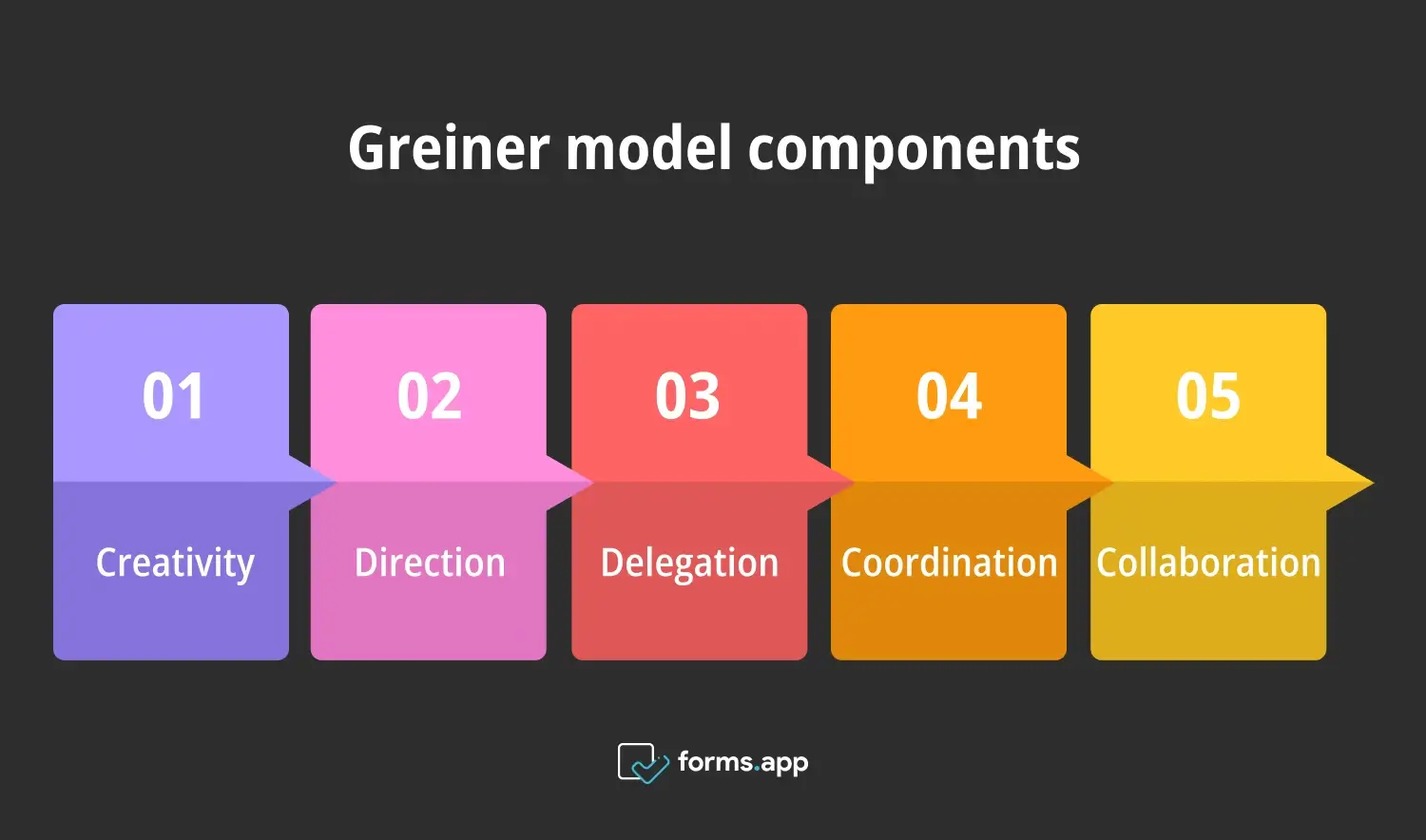
Components of the Greiner Model
Creativity
Our first phase is Creativity. In this phase, your company should focus on developing new products or services. Naturally, innovation and creativity drive your business. However, as your company grows, the ways of informal management will become insufficient. Therefore, the Leadership Crisis will arise. To solve this crisis, formal leadership and management practices will be required.
Direction
In the second phase of Direction, your company will establish formal structures and new management practices. Here, your focus should be on clear goals and roles. The leadership becomes more centralized. Therefore, your company should focus on efficiency and stability. This phase aims to make things calmer after the initial chaos of the Creativity phase.
Delegation
Our third phase, Delegation, will address the need for greater autonomy. After your leadership decentralizes, it should strengthen middle managers to make decisions and take responsibility. In this phase, you should encourage innovation and responsibility at lower levels of the organization. However, as your company grows, this decentralization will also lead to a control crisis.
Coordination
The fourth phase is Coordination. Here, your company creates systems to integrate different departments and functions. Standard procedures, formal planning, and communication channels will ensure coordination between your departments. Its ultimate aim is to bring order to the decentralized structure from the Delegation phase. But now, this increased coordination will lead to a red tape crisis.
Collaboration
Here we are at our final phase: Collaboration. In this phase of the Greiner Model. Your company should focus on teamwork, flexibility, and a collaborative culture here. Formal structures give way to a more organic approach, where cross-functional teams work together towards common goals. The departments of your company should collaborate to overcome bureaucratic problems, such as the red tape crisis.
The Greiner Model Template: How your company can use it
Applying Greiner's Model of Organizational Growth starts with you understanding which phase of growth is experiencing. Another vital part is anticipating and preparing for the potential challenges coming your way. Use a Greiner Model template. Start by assessing your current stage of growth. Identify the key characteristics and challenges of that phase.
We mentioned some of the crises above: crisis of leadership, autonomy crisis, and red tape crisis. To address sustainable growth, addressing evolution and revolution as your organization grows is very important. We recommend that you outline the above components and use a Greiner Model template. This way, you can centralize or decentralize your management style and ensure growth.
Why is the Greiner Model important?
'Why is the Greiner Model important?' you may ask. Let’s discuss the answer to this question. As far as we are concerned, your question has 8 answers. We’ll dive into each of these in detail. By leveraging this model, you can ensure sustainable success and better navigate the complexities of organizational development. Now, let's explore the key reasons:

Importance of the Greiner Model
1- Anticipate challenges
First of all, the Greiner Model will help your businesses anticipate challenges at each growth stage. If you understand the potential crises that can arise, you can proactively develop strategies to address them in your organization. This will reduce the likelihood of becoming vulnerable to them. You will ensure a smoother transition between phases. Anticipating challenges also allows leaders to allocate resources more effectively.
2- Structured growth
Secondly, you will have a structured approach to growth at your disposal. The model outlines clear phases and transitions, offering a roadmap for development. Thus, it will help your business plan growth strategically. This, in turn, ensures that you manage each stage effectively. By following the model, companies can avoid unplanned expansion and the problems that come along with it.
3- Improved management
Thirdly, the Greiner Model focuses on the importance of evolving management practices. You can understand the need for different leadership styles and structures. So, you can adapt their management approach to suit their current phase. This adaptability improves your overall management effectiveness. This will ultimately lead to better decision-making and more efficient operations in your company.
4- Enhanced coordination
Fourthly, as your company grows, coordination between different departments and functions becomes vital. The Greiner Model highlights the importance of establishing systems and processes for effective coordination. By focusing on coordination, your business can ensure that all parts work together seamlessly and smoothly. Enhanced coordination leads to greater efficiency, reduces duplication of effort, and brings enhanced happiness.
5- Crisis management
Another aspect is that this model provides insights into potential crises that may occur at each growth stage. If you understand these crises, you will be able to develop effective crisis management strategies. This readiness helps you navigate challenging situations more effectively. It will also minimize the impact on operations and morale. You will realize that crisis management is a critical component of your long-term success.
6- Adaptability
We should touch on another good point. The Greiner Model encourages your business to adapt and respond to changing circumstances. Each growth phase requires different approaches and solutions. If you embrace adaptability, your company can remain agile and resilient in the face of change. This flexibility allows you to seize new opportunities, innovate, and stay ahead of your competitors.
7- Strategic planning
This model is also great for strategic planning. By understanding the stages of growth and potential crises, you can create more informed and effective strategic plans. The model provides a framework for setting realistic goals, identifying priorities, and allocating resources. Strategic planning based on The Greiner Model will help your business align the efforts of your units with long-term objectives.
8- Employee development
Last but not least, the Greiner Model emphasizes the importance of developing employees at each stage. As your company evolves, you will realize that you need different skills and competencies. By recognizing this, you can invest in targeted training and development programs. Employee development ensures that your workforce can handle new challenges and responsibilities.
Examples of the Greiner Model
Now, let's look at examples of the Greiner Growth Model. We will examine three hypothetical scenarios for three different kinds of companies. If you understand these examples well, you can also navigate the stages of growth and address the associated challenges in your company.
Example 1: A tech startup
Imagine that a tech startup begins in the Creativity phase. It focuses on developing innovative software solutions. As it grows, it faces a Leadership Crisis. It realizes the need for formal management. Therefore, when it reaches to the Direction phase, the startup establishes clear roles and goals. However, as it continues to expand, middle managers start to seek more autonomy.
This leads to the Delegation phase. When the startup empowers these managers, the company fosters innovation at lower levels. But now, the company needs better coordination. This, in turn, prompts a shift to the Coordination phase. In the final phase, the company ensures that various departments are aligned. In this scenario, the tech startup was able to successfully defuse the leadership crisis.
Example 2: A retail chain
Our second scenario is a retail chain. Our retail chain starts in the Creativity phase, with founders driving growth through innovative marketing strategies. As the chain expands, the need for structured management becomes more apparent. This, again, leads to a Leadership Crisis. The company wants to implement formal management practices when it gets to the Direction phase.
Over time, middle managers of the retail chain desire more decision-making power. This prompts a shift to the Delegation phase. The retail chain decentralizes. This empowers regional managers. The company then moves to the Coordination phase to ensure consistency and alignment. It establishes standardized procedures and communication channels across all units. Problem solved!
Example 3: A manufacturing firm
Our third and final example is a manufacturing firm. It begins in the Creativity phase, focusing on developing unique products. As demand increases, the firm encounters a Leadership Crisis. In the Direction phase, the firm establishes clear goals and structures. As growth continues, the voices of middle managers rise for more autonomy. Off we go to the Delegation phase.
Our firm gives more decision-making powers to the middle managers. But now, we face a coordination problem. As the company grows further, it focuses more on collaboration. Now, cross-functional teams work together to drive innovation and efficiency. So, the manufacturing firm was able to ensure sustainable growth while solving the problems along the way.
Advantages and Disadvantages
Now, let’s look at the advantages and disadvantages of The Greiner Model. As we have talked about above, this model has many advantages. However, it also has challenges, and you should not rely solely on it for your business. Let’s understand both faces of the coin. This will provide a balanced view of this valuable framework.
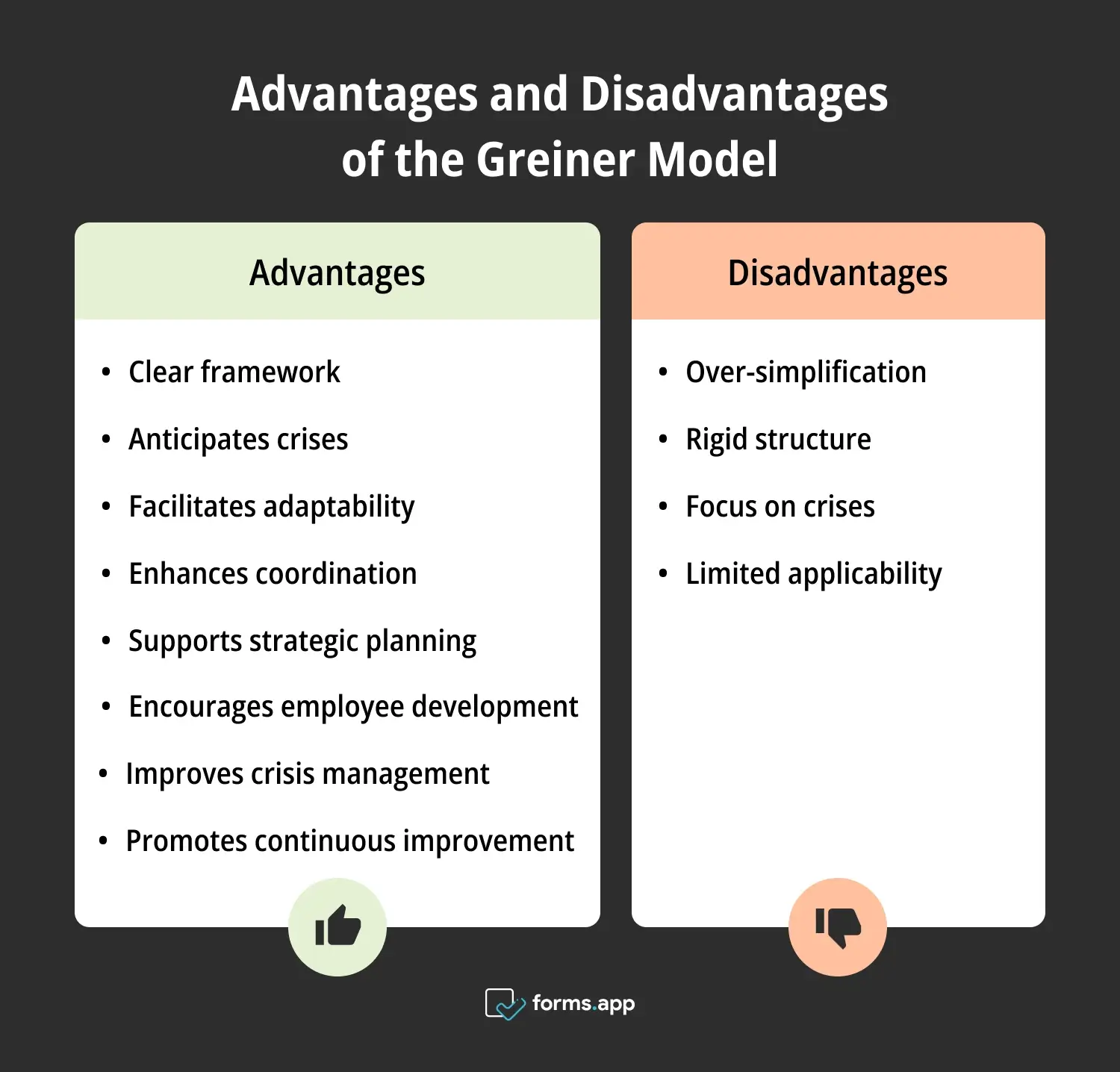
Pros and cons of the Greiner Model
Advantages:
1- Clear framework: The Greiner Model provides a clear framework for understanding organizational growth. It outlines distinct phases and associated challenges. It will help your business anticipate and prepare for each stage. This clarity enables more effective planning and management. It also reduces uncertainty and promotes confidence in decision-making.
2- Anticipates crises: The Greiner Model identifies potential crises at each growth stage. It allows your company to proactively address issues before they become critical. This, in turn, helps prevent disruptions and ensures smoother transitions between phases. It contributes to more stable and sustained growth within your organization.
3- Facilitates adaptability: The model emphasizes the need for adaptability in management practices. As you progress through different phases, you must adjust your leadership styles and structures accordingly. This focus on adaptability helps your organization remain agile and responsive to changing circumstances.
4- Enhances coordination: The Greiner Model highlights the importance of coordination as your company grows. It emphasizes the need for standardized procedures and communication channels. It also helps your business align your efforts across different departments and functions. This leads to greater efficiency and coherence between your departments.
5- Supports strategic planning: Using the Greiner Model aids in strategic planning by providing a roadmap for growth. It helps your business set realistic goals, identify priorities, and allocate resources effectively. This strategic approach ensures that your growth is purposeful and aligned with long-term objectives.
6- Encourages employee development: The model focuses on the importance of developing employees to meet the demands of your company. Your organization invests in targeted training and development programs. You can also ensure that the workforce can handle new challenges and responsibilities.
7- Improves crisis management: Understanding the potential crises associated with each growth stage enables your business to develop effective crisis management strategies. This readiness will help your organization navigate challenging situations more effectively. This minimizes the impact on operations and morale.
8- Promotes continuous improvement: The Greiner Model encourages a culture of continuous improvement in your organization. If you regularly assess the organizational growth stage and adapt strategies accordingly, your company can foster innovation and drive ongoing development. Don’t forget, you will also be able to address the problems and challenges coming along the way.
Disadvantages
1- Over-simplification: Now, you should bear in mind that the Greiner Model may oversimplify the complexities of organizational growth. Real-world scenarios often involve overlapping stages and more complex challenges that may not fit into the phases.
2- Rigid structure: The model's structured approach may not suit all organizations, including yours. Some companies may find the prescribed phases too rigid and inflexible. This may limit your ability to adapt to unique circumstances or unconventional growth paths.
3- Focus on crises: The emphasis on crises at each stage may create a negative mindset. According to this model, there are crises and potential problems rather than opportunities. This perspective can impact morale and hinder a proactive, opportunity-driven approach to growth in your departments.
4- Limited applicability: Last but not least, the Greiner Model may not apply to all types of organizations or industries. If your company has an unconventional structure or is operating in rapidly changing environments, there is a chance that you may find the model less relevant or useful.
When to Use The Greiner Model
Below, we’ll look at when to use The Greiner Model. By identifying the right situations for applying this framework, you can maximize its benefits. We'll discuss various scenarios where The Greiner Model is particularly useful. This will help you determine the best times to implement it for effective organizational growth and development.
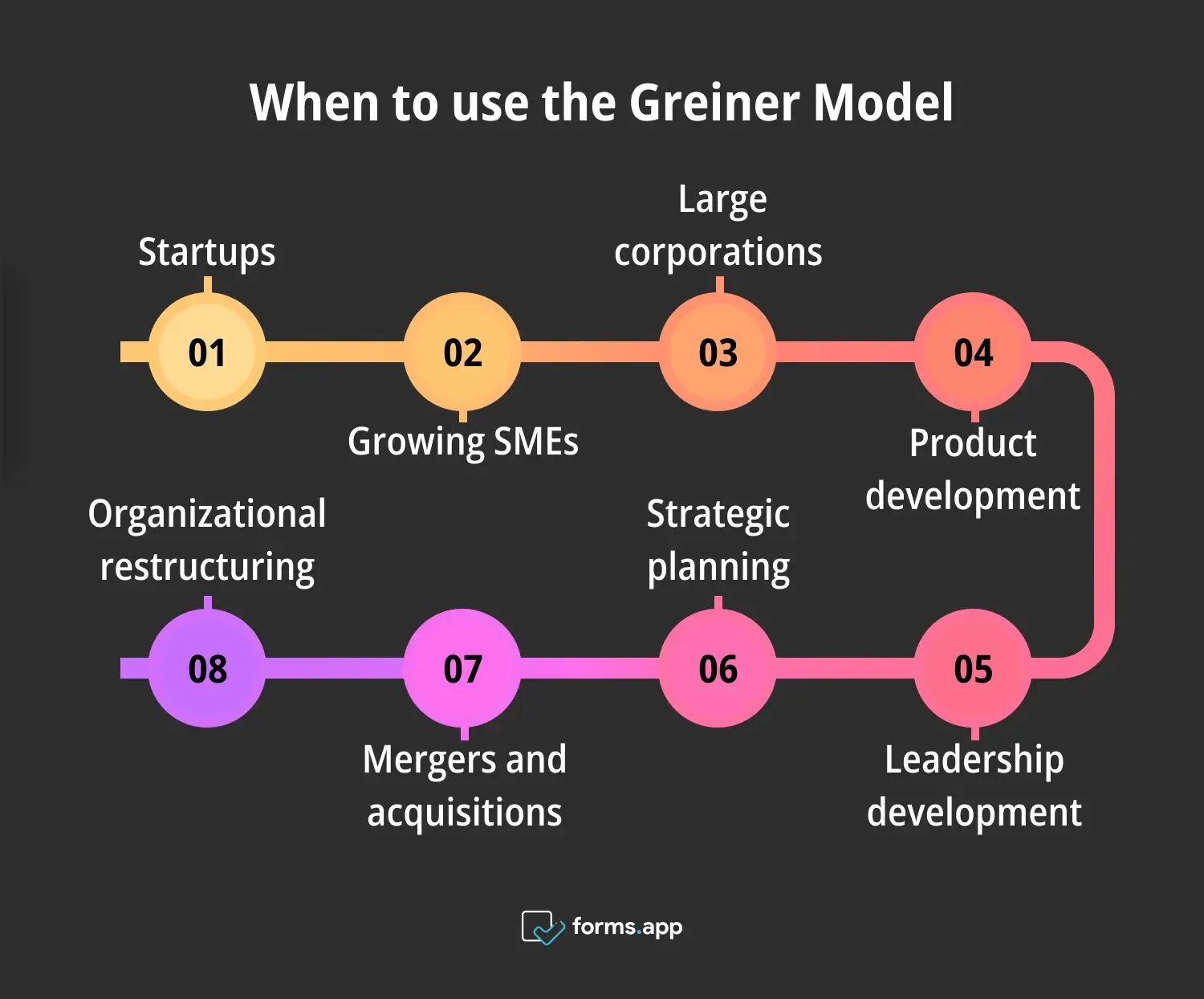
Right times to use the Greiner Model
1- Startups
The Greiner Model is particularly useful for startups experiencing rapid growth. It helps founders and leaders understand the stages of development they will go through. It also enables them to anticipate the challenges associated with each phase. By using the model, startups can plan for sustainable growth and avoid common pitfalls.
2- Growing SMEs
Small and medium-sized enterprises (SMEs) that are expanding can benefit from the Greiner Model. It provides a structured approach to managing growth. This ensures that SMEs can navigate the complexities of scaling up without losing focus or direction.
3- Large corporations
Even large corporations can use the Greiner Model to manage growth within different divisions or subsidiaries. The model helps identify which phase each part of the organization is in. It also assists companies in developing tailored strategies to address their specific challenges.
4- Organizational restructuring
Companies undergoing restructuring can use the Greiner Model to guide their efforts. The model provides insights into how to manage the transition between different growth stages. It also gives ideas about ensuring that the organization emerges stronger from the restructuring process.
5- Mergers and acquisitions
During mergers and acquisitions, the Greiner Model can help companies understand the growth stages of the newly combined entity. It provides a framework for integrating different organizational cultures and management practices, ensuring a smooth transition and effective collaboration.
6- Strategic planning
The Greiner Model is valuable for strategic planning. By understanding the stages of growth and potential crises, companies can create more informed and effective strategic plans. These plans will align with their long-term objectives and ensure sustainable success.
7- Leadership development
The model can contribute to leadership development programs. It helps current and future leaders understand the different stages of organizational growth. It also helps develop the skills needed to manage each phase effectively.
8- Crisis management
Companies facing significant challenges can use the Greiner Model to develop effective crisis management strategies. Organizations can understand the potential crises associated with each growth stage. Doing so, they can proactively address issues and navigate through difficult times.
Frequently asked questions about the Greiner Model
Finally, let's address some frequently asked questions about The Greiner Model. These answers will help clarify key concepts, provide additional insights, and enhance your understanding of this growth framework. By exploring these common queries, you'll gain a deeper appreciation of how The Greiner Model can benefit your organization.
A teoria do ciclo de vida organizacional de Greiner descreve cinco fases de crescimento organizacional: Criatividade, Direção, Delegação, Coordenação e Colaboração. Cada fase envolve desafios específicos e possíveis crises. Compreender essas fases ajuda as empresas a navegar no crescimento de forma mais eficaz, antecipar problemas e implementar práticas de gestão adequadas para garantir o desenvolvimento sustentável e o sucesso a longo prazo.
A curva de Greiner ilustra as etapas do crescimento organizacional e as crises que ocorrem em cada etapa. Ela representa visualmente as transições de uma fase para outra, destacando os desafios e mudanças de gestão necessárias. A curva ajuda as empresas a antecipar e lidar com esses desafios, garantindo um crescimento e desenvolvimento mais suaves.
O modelo de crescimento de Greiner fornece um quadro claro para entender o crescimento organizacional, antecipa possíveis crises e facilita a adaptabilidade nas práticas de gestão. Ele melhora a coordenação, apoia o planejamento estratégico, incentiva o desenvolvimento dos funcionários e melhora a gestão de crises. Ao usar esse modelo, as empresas podem alcançar um crescimento estruturado e sustentável e navegar pelas complexidades da escalabilidade de forma eficaz.
Um estudo de caso do Modelo de Crescimento Greiner analisa a jornada de uma empresa através das fases de crescimento do modelo. Ele examina como a empresa navegou por cada fase, abordando crises como liderança e autonomia. Além disso, mostra como a organização ajustou seu estilo de gestão e estrutura. Isso leva a um crescimento sustentável e sucesso organizacional de longo prazo, fornecendo insights valiosos e exemplos práticos para outras empresas.
Final words
The Greiner Model of Change offers valuable insights into the stages of organizational growth and the challenges that arise at each phase. By understanding and applying this model, businesses can anticipate and address potential crises, ensure structured and sustainable growth, and improve overall management practices. The model's emphasis on adaptability, coordination, and strategic planning makes it a powerful tool for leaders.
In this article, we explored the definition and components of The Greiner Model, its importance, practical examples, advantages, and disadvantages, and when to use it. By understanding and applying this model, you can better manage your company's growth and navigate the challenges associated with each stage. Use The Greiner Model as a guide for strategic planning and decision-making now!
Fatih is a content writer at forms.app and a translator specializing in many text domains, including medical, legal, and technical. He loves studying foreign languages. Fatih especially likes to create content about program management, organizational models, and planning tools.



 13 min ler
13 min ler